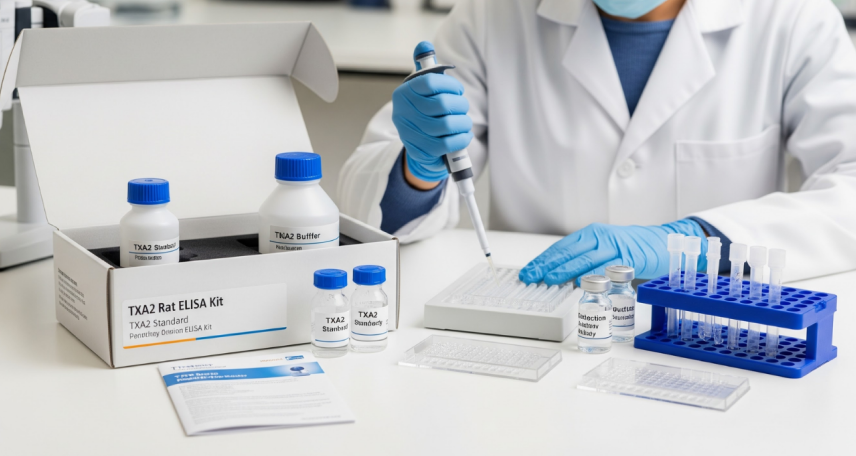by Team Pharma Now
null minutes
Thromboxane A2 and Its Impact on Inflammation and Disease
Learn TXA2’s role in disease and how TXA2 rat ELISA kits track its activity in heart, lung, kidney, and brain research.

Thromboxane A2 (TXA2) is a lipid compound that acts like a messenger in the body. It has a big role in clotting blood and controlling how blood vessels behave. High levels of TXA2 can result from factors such as inflammation, oxidative stress, increased platelet activation, and certain diseases like diabetes and cardiovascular disorders. While it serves a purpose in normal defence and repair, too much TXA2 can backfire. High levels are tied to chronic inflammation and a number of diseases. Researchers often turn to a TXA2 rat ELISA kit to measure its activity because it offers reliable results across different types of samples.
Role of Thromboxane A2 in the Body
TXA2 is mainly produced by platelets, the blood cells that clump together when we get a cut. Its job is to speed up clot formation and prevent too much bleeding. At the same time, it narrows blood vessels, which also helps reduce blood loss.
Some of its major functions are:
- Supporting platelet clumping during injury
- Limiting blood flow to reduce bleeding
- Controlling blood vessel contraction and relaxation
- Sending signals that trigger inflammation when needed
These actions are useful in short bursts. Trouble begins when TXA2 stays elevated for longer than the body can handle.
TXA2 and Inflammation
Inflammation is meant to be a short-term defence, but TXA2 often makes the response stronger and more persistent. It recruits immune cells and tightens blood vessels, which can keep the cycle going.
When TXA2 is too high, you may see:
- Excess buildup of immune cells in tissues
- More redness and swelling
- Stronger pain signals
- Lasting tissue damage
Instead of healing, the body ends up stuck in an ongoing inflammatory state, which is a common feature of many diseases.
TXA2 in Heart and Blood Vessel Disease
Platelets become overactive when TXA2 remains high, raising the chance of blood clots in arteries. These clots can block circulation and trigger severe events.
Health problems linked to TXA2 include:
- Heart attacks
- Stroke
- Elevated blood pressure
- Atherosclerosis (plaque buildup in arteries)
Because of this connection, many scientists focus on TXA2 when studying cardiovascular protection and treatment strategies.
TXA2 in Lung and Breathing Disorders
The lungs are sensitive to changes in blood flow and airway control. High TXA2 levels can make airways tighten and cause inflammation, leading to breathing difficulties.
Conditions where TXA2 plays a role include:
- Asthma attacks
- COPD flare-ups
- Allergic airway swelling
By monitoring TXA2, researchers can better understand how much it contributes to lung conditions and track how well treatments are working.
TXA2 in Kidney Health
The kidneys need a steady blood flow to filter waste. TXA2 interferes with this by narrowing vessels and sparking inflammation inside kidney tissue. Over time, the results can include:
- Reduced kidney efficiency
- Tissue injury
- Raised blood pressure
Studying TXA2 levels gives insight into kidney disease progression and opens doors to possible interventions.
TXA2 and the Brain
Too much TXA2 also affects the brain. During strokes, it often plays a role in clot formation that cuts off the blood supply. It has also been linked to brain inflammation, which is connected to neurodegenerative disorders. This makes TXA2 a focus for research on brain health and recovery.
Role of Research Tools
To track these changes, researchers rely on tools that measure TXA2 accurately. The TXA2 rat ELISA kit is one of the most effective options because it:
- Detects even very low levels of TXA2
- Works with blood, urine, and tissue samples
- Produces consistent results across experiments
- Supports studies on heart, lung, kidney, and brain health
With such kits, scientists gain a clearer picture of how TXA2 acts in different diseases. The TXA2 rat ELISA kit also helps them know how therapies might lower its harmful effects.
Key Points to Take Away
- TXA2 helps with normal clotting and vessel control, but too much of it is damaging.
- High TXA2 keeps inflammation going and worsens many conditions.
- It is linked with heart disease, lung disorders, kidney issues, and brain complications.
Bottom Line
Being aware of how inflammation leads to disease starts with measuring players like TXA2. While it’s a tiny molecule, its impact is far-reaching. With the TXA2 rat ELISA kit, scientists can track its activity clearly and consistently. This helps uncover new insights, test treatments, and move closer to better therapies — all through dependable, hands-on science.




